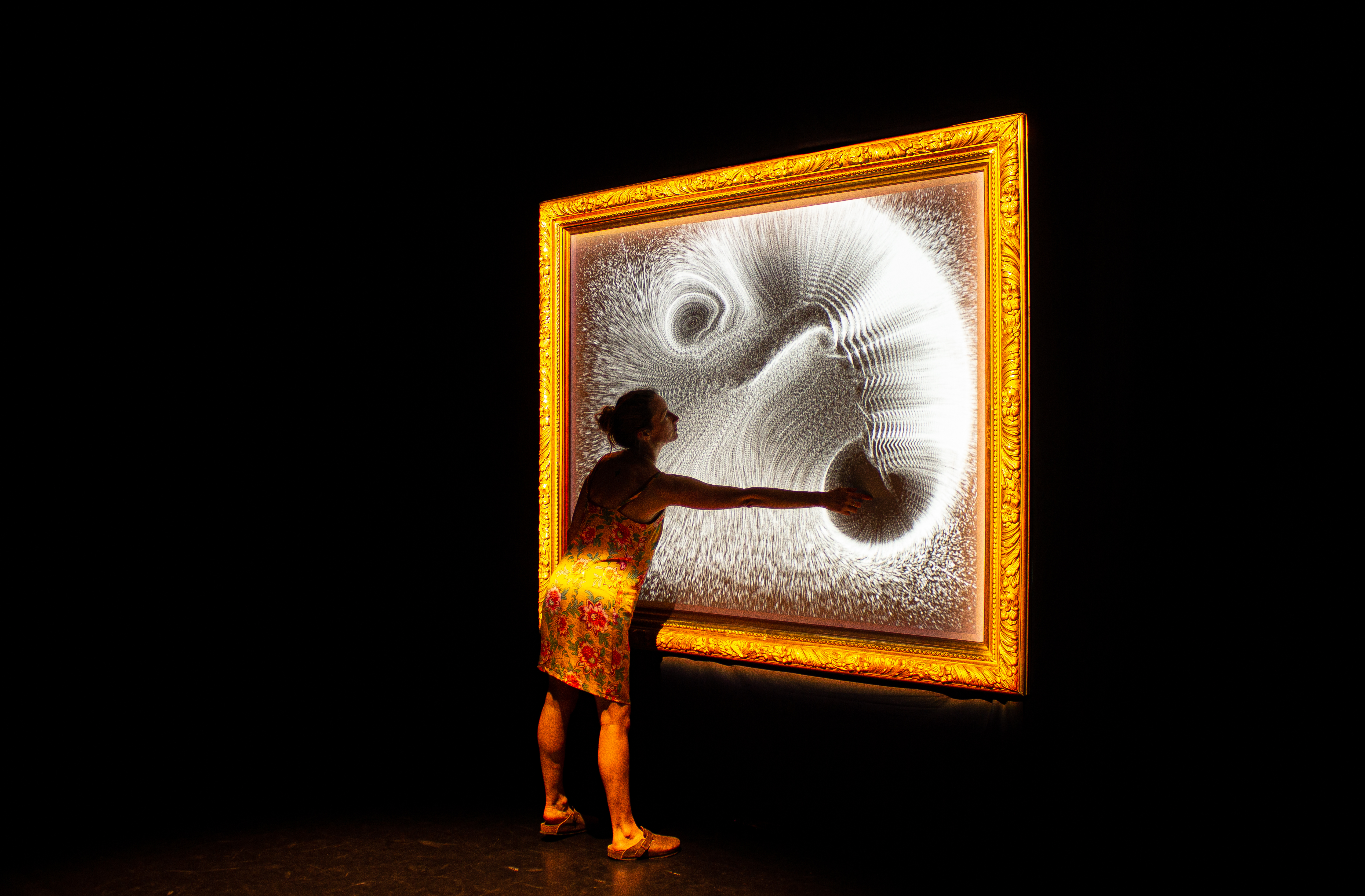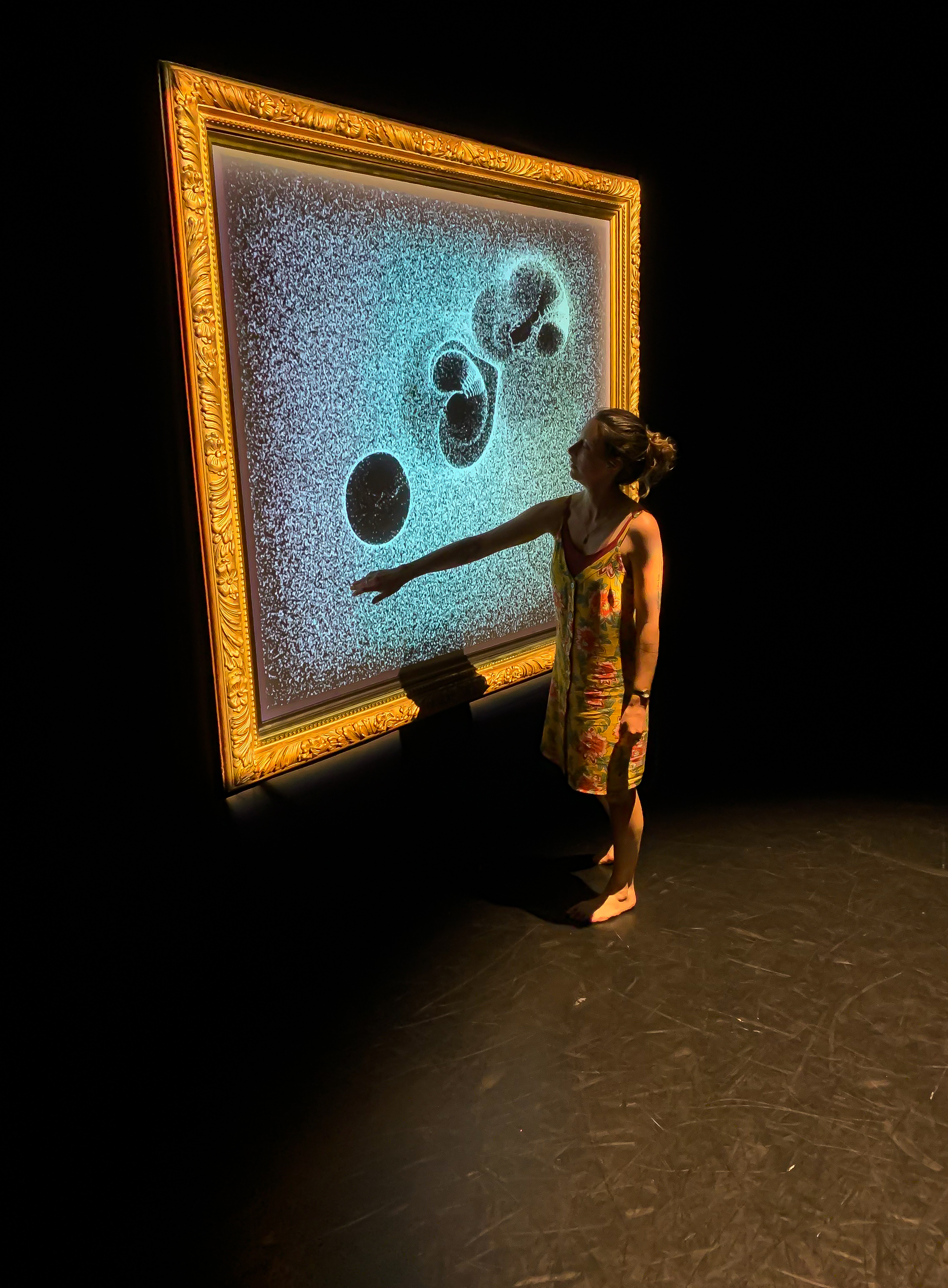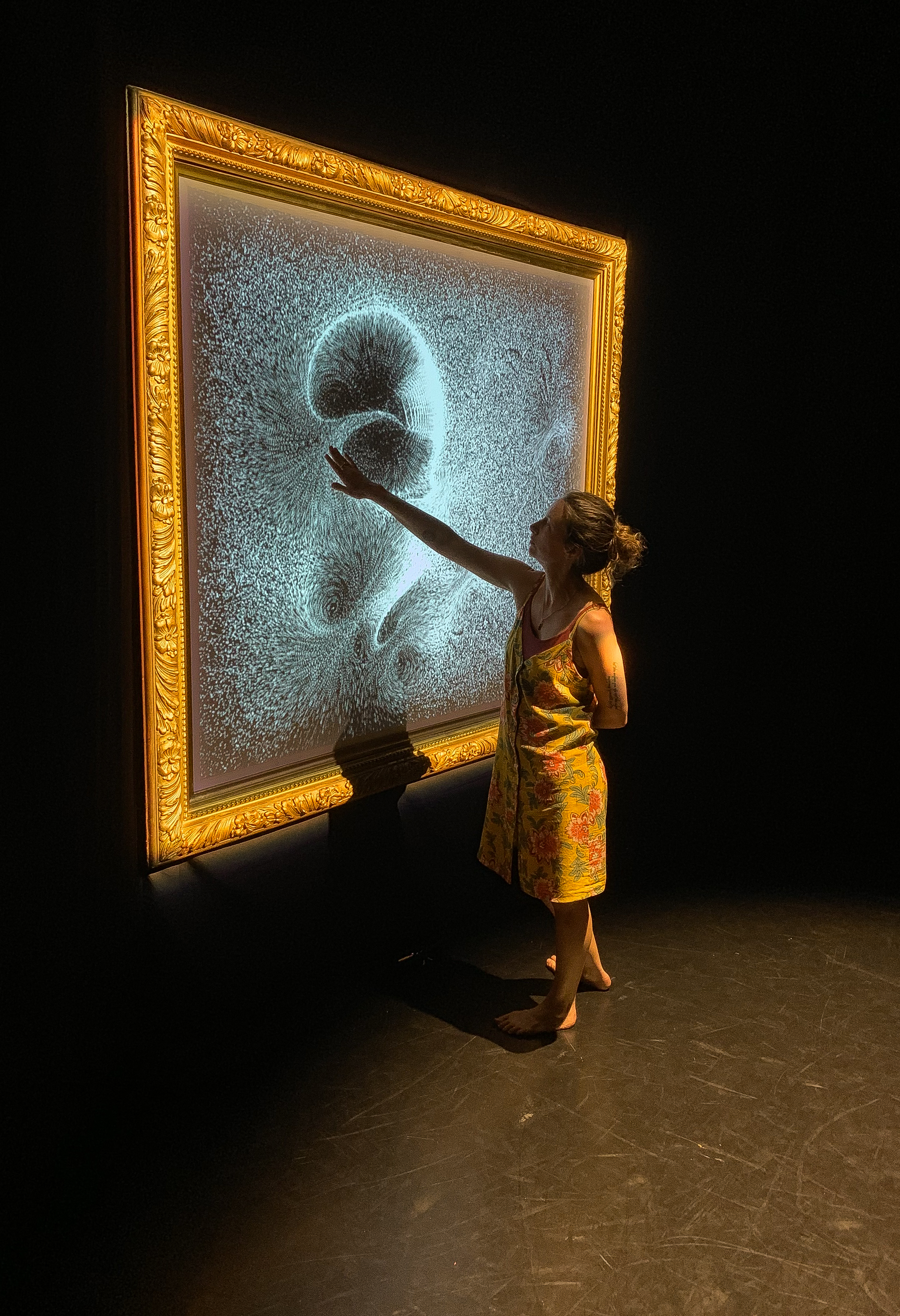T o u c h (2 0 1 9)

“As soon as something is classified as art, its non-visual qualities are suppressed, and, as trained spectators, we know that the right thing to do is stand back and look at it.”
Howes & Classen 2014, p,17.
Howes & Classen 2014, p,17.
Project detail:
This mixed media installation mobilises a range of critical art practices to interrogate the “traditional relationship between the art object, the artist and the audience” (Bishop, 2012). These long-established and well-defined relationships comprehend the ‘art object’ as a discrete, stable, and commodifiable artefact, the ‘artist’ as auteur or master, and the ‘audience’ as an undifferentiated and passive spectator.
Technical detail:
- 182.8cm(h) x 213.3cm(w) Stucco frame
- Stretched cotton canvas
- Rear projection
- Kinect camera

This haptically-driven interactive installtion was exhibited at the Association of Medical Humanities[1] annual conference[2] held at the University of Plymouth between 26th and 28th June 2019. Accompanied by a conference paper titled Immateriality in The Clinic: Legitimising Arts Practice in the Production of Medical Knowledge the installation was set up in the main theatre space of The House[3] performing arts centre located on the university’s city centre campus.
The installation was built around a ninety-year-old stucco frame measuring 182cm(h) x 213cm(w). Hung in the centre of the theatre, the frame was masked from floor to ceiling using blackout stage curtains. This design served to focus participants attention towards the artefact and create a necessary frontstage and backstage. The installation was front lit using ceiling mounted Fresnel lights that were rigged to throw shade on the canvas and focus light onto the stucco frame.
A white cotton canvas was affixed to a wooden stretcher built to fit the rebate aperture of the stucco frame. The stretcher was then mounted to the rebate which created a secure and framed projection surface. A 1920x1080p projector was rigged backstage to offer a rear projection visible to the audience frontstage through the canvas. This arrangement ensured the projection was unaffected by audience movement or blocked by the body position of individual participants while interacting with the installation. The projected moving image was a particle system generated using a pixel shader in Touchdesigner[5]. Touchdesigner was also used for projection mapping the particle system onto the limits of the canvas.
A Microsoft Kinect v2[6] was installed backstage alongside the projector and pointed at the rear of the canvas. The Kinects infra-red camera was utilised to accurately track the point of contact between participants fingertips and the canvas using depth changes across the material surface. Touchdesigner was used to process the Kinect information into calibrated positional data and fed into the pixel shader via a simple optical flow network. The low-latency and accurate position data was used to drive real-time interaction with the particle system.
The default position of the particle system was static with the activation of individual particles being triggered by touching the canvas as described above. Ripples and waves of movement across the particle system would emanate from the point of contact with the canvas. The particles movement matched the position, speed, and direction of the depth displacement on the canvas. The movement would propagate across the particle system in a way that imitated, or at least approximated, fluid dynamics to bounce and refract off the limits of the pixel shader that were mapped to the edges of the visible frame. When participants broke off contact with the canvas, the live position data stream would stop and the particle system took approximately 30 seconds to return to the default static position.
Challenging a pervasive tendency to render art audiences as passive, attend exclusively to visual qualities, and aestheticize forms of interpretation rather than stimulate poly-sesnory forms of experience and interaction; the spectator here becomes actant, one equal componant in a messy network of technological, material (hardware), digital (software), and human (wetwear) relations. Requiring both physical movement and tactile involvement the viewer is here recast from an observer to become a necessary component of the artwork.
Bishop, C. (2012) Artificial Hells: Participatory Art and the Politics of Spectatorship. London and New York: Verso.
Howes, D. Classen, C. (2014) Ways of Sensing. London & NewYork: Routledge.
[1] The Association of Medical Humanities, https://amh.ac.uk
[2] `the 2019 annual conference was titled Material Medicine: Objects and Bodies, https://amh.ac.uk/events/conferences/amh-conference-2019-plymouth-uk/
[3] https://www.plymouth.ac.uk/about-us/university-structure/faculties/arts-humanities-business/the-house
[5] Touchdesigner, a node based visual programming environment for real time interactive multimedia context, www.derivative.com
[6] Microsoft Kinect v2 https://developer.microsoft.com/en-us/windows/kinect/
The installation was built around a ninety-year-old stucco frame measuring 182cm(h) x 213cm(w). Hung in the centre of the theatre, the frame was masked from floor to ceiling using blackout stage curtains. This design served to focus participants attention towards the artefact and create a necessary frontstage and backstage. The installation was front lit using ceiling mounted Fresnel lights that were rigged to throw shade on the canvas and focus light onto the stucco frame.
A white cotton canvas was affixed to a wooden stretcher built to fit the rebate aperture of the stucco frame. The stretcher was then mounted to the rebate which created a secure and framed projection surface. A 1920x1080p projector was rigged backstage to offer a rear projection visible to the audience frontstage through the canvas. This arrangement ensured the projection was unaffected by audience movement or blocked by the body position of individual participants while interacting with the installation. The projected moving image was a particle system generated using a pixel shader in Touchdesigner[5]. Touchdesigner was also used for projection mapping the particle system onto the limits of the canvas.
A Microsoft Kinect v2[6] was installed backstage alongside the projector and pointed at the rear of the canvas. The Kinects infra-red camera was utilised to accurately track the point of contact between participants fingertips and the canvas using depth changes across the material surface. Touchdesigner was used to process the Kinect information into calibrated positional data and fed into the pixel shader via a simple optical flow network. The low-latency and accurate position data was used to drive real-time interaction with the particle system.
The default position of the particle system was static with the activation of individual particles being triggered by touching the canvas as described above. Ripples and waves of movement across the particle system would emanate from the point of contact with the canvas. The particles movement matched the position, speed, and direction of the depth displacement on the canvas. The movement would propagate across the particle system in a way that imitated, or at least approximated, fluid dynamics to bounce and refract off the limits of the pixel shader that were mapped to the edges of the visible frame. When participants broke off contact with the canvas, the live position data stream would stop and the particle system took approximately 30 seconds to return to the default static position.
Challenging a pervasive tendency to render art audiences as passive, attend exclusively to visual qualities, and aestheticize forms of interpretation rather than stimulate poly-sesnory forms of experience and interaction; the spectator here becomes actant, one equal componant in a messy network of technological, material (hardware), digital (software), and human (wetwear) relations. Requiring both physical movement and tactile involvement the viewer is here recast from an observer to become a necessary component of the artwork.
Bishop, C. (2012) Artificial Hells: Participatory Art and the Politics of Spectatorship. London and New York: Verso.
Howes, D. Classen, C. (2014) Ways of Sensing. London & NewYork: Routledge.
[1] The Association of Medical Humanities, https://amh.ac.uk
[2] `the 2019 annual conference was titled Material Medicine: Objects and Bodies, https://amh.ac.uk/events/conferences/amh-conference-2019-plymouth-uk/
[3] https://www.plymouth.ac.uk/about-us/university-structure/faculties/arts-humanities-business/the-house
[5] Touchdesigner, a node based visual programming environment for real time interactive multimedia context, www.derivative.com
[6] Microsoft Kinect v2 https://developer.microsoft.com/en-us/windows/kinect/


